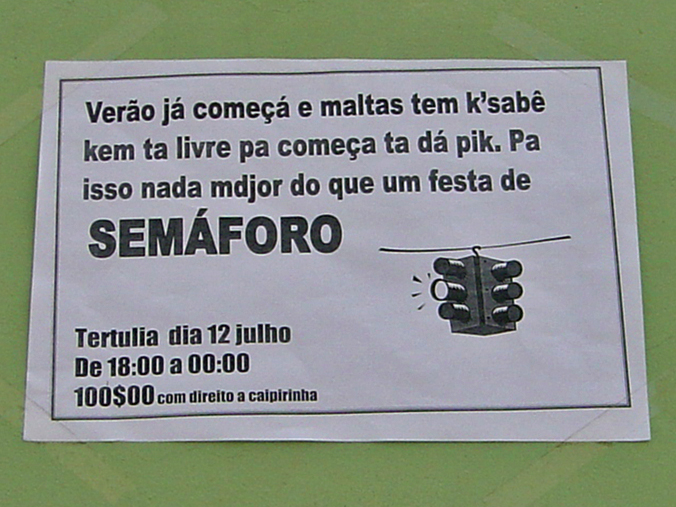|
Santo Antão Creole
Santo Antão Creole, is the name given to the variant of Cape Verdean Creole spoken mainly in the Santo Antão Island of Cape Verde Cape Verde or Cabo Verde, officially the Republic of Cabo Verde, is an island country and archipelagic state of West Africa in the central Atlantic Ocean, consisting of ten volcanic islands with a combined land area of about . These islands .... It belongs to the Barlavento Creoles branch. It is ranked third of nine in the number of speakers and it is before Fogo and after the neighbouring São Vicente. Characteristics Besides the main characteristics of Barlavento Creoles the Santo Antão Creole has also the following ones: * The progressive aspect of the present is formed by putting ''tí tâ'' before the verbs: ''tí'' + ''tâ'' + V. * The adverb of negation used with verbs, adverbs and adjectives is ''n’''. Ex.: ''Mí n’ crê'' instead of ''M’ câ crê'' “I don’t want”. * The sounds and are palatalized to and when they are ... [...More Info...] [...Related Items...] OR: [Wikipedia] [Google] [Baidu] |
Cape Verdean Creole
Cape Verdean Creole is a Portuguese-based creole languages, Portuguese-based creole language spoken on the islands of Cape Verde. It is the native creole language of virtually all Cape Verdeans and is used as a second language by the Cape Verdean diaspora. The creole has particular importance for creolistics studies since it is the oldest living creole. It is the most widely spoken Portuguese-based creole language. The full, formal name is Cape Verdean Creole (), but in everyday usage the creole is simply called "Creole" () by its speakers. Origins The history of Cape Verdean Creole is hard to trace due to a lack of written documentation and to ostracism during the Portuguese administration of Cape Verde. There are presently three theories about the formation of Cape Verdean Creole. The monogenetic theory of pidgins, monogenetic theory claims that the creole was formed by the Portuguese by simplifying the Portuguese language in order to make it accessible to enslaved Afr ... [...More Info...] [...Related Items...] OR: [Wikipedia] [Google] [Baidu] |
Santo Antão, Cape Verde
Santo Antão (Portuguese language, Portuguese for "Anthony the Great, Saint Anthony") is the northwesternmost island of Cape Verde. At , it is the largest of the Barlavento Islands group, and the second largest island of Cape Verde.Cabo Verde, Statistical Yearbook 2015 Instituto Nacional de Estatística (Cape Verde), Instituto Nacional de Estatística The nearest island is São Vicente, Cape Verde, São Vicente to the southeast, separated by the sea channel Canal de São Vicente. Its population was 38,200 in mid 2019,Instituto Nacional de Estatística, Cabo Verde (web). making it the fourth most populous island of Cape Verde after Santiago, Cape Verde, Santiago, São Vicente and Sal. Its largest city is Porto Novo, Cape Verde, Porto Novo located on the ... [...More Info...] [...Related Items...] OR: [Wikipedia] [Google] [Baidu] |
Cape Verde
Cape Verde or Cabo Verde, officially the Republic of Cabo Verde, is an island country and archipelagic state of West Africa in the central Atlantic Ocean, consisting of ten volcanic islands with a combined land area of about . These islands lie between west of Cap-Vert, the westernmost point of continental Africa. The List of islands of Cape Verde, Cape Verde islands form part of the Macaronesia ecoregion, along with the Azores, the Canary Islands, Madeira and the Savage Isles. The Cape Verde archipelago was uninhabited until the 15th century, when Portuguese Empire, Portuguese explorers colonized the islands, establishing one of the first Age of Discovery, European settlements in the tropics. Due to its strategic position, Cape Verde became a significant location in the Atlantic slave trade, transatlantic slave trade during the 16th and 17th centuries. The islands experienced economic growth during this period, driven by their role by the rapid emergence of merchants, priva ... [...More Info...] [...Related Items...] OR: [Wikipedia] [Google] [Baidu] |
Barlavento Creoles
Cape Verdean Creole is a Portuguese-based creole language spoken on the islands of Cape Verde. It is the native creole language of virtually all Cape Verdeans and is used as a second language by the Cape Verdean diaspora. The creole has particular importance for creolistics studies since it is the oldest living creole. It is the most widely spoken Portuguese-based creole language. The full, formal name is Cape Verdean Creole (), but in everyday usage the creole is simply called "Creole" () by its speakers. Origins The history of Cape Verdean Creole is hard to trace due to a lack of written documentation and to ostracism during the Portuguese administration of Cape Verde. There are presently three theories about the formation of Cape Verdean Creole. The monogenetic theory claims that the creole was formed by the Portuguese by simplifying the Portuguese language in order to make it accessible to enslaved African people. That is the point of view of authors like Prudent, ... [...More Info...] [...Related Items...] OR: [Wikipedia] [Google] [Baidu] |
French Language
French ( or ) is a Romance languages, Romance language of the Indo-European languages, Indo-European family. Like all other Romance languages, it descended from the Vulgar Latin of the Roman Empire. French evolved from Northern Old Gallo-Romance, a descendant of the Latin spoken in Northern Gaul. Its closest relatives are the other langues d'oïl—languages historically spoken in northern France and in southern Belgium, which French (Francien language, Francien) largely supplanted. It was also substratum (linguistics), influenced by native Celtic languages of Northern Roman Gaul and by the Germanic languages, Germanic Frankish language of the post-Roman Franks, Frankish invaders. As a result of French and Belgian colonialism from the 16th century onward, it was introduced to new territories in the Americas, Africa, and Asia, and numerous French-based creole languages, most notably Haitian Creole, were established. A French-speaking person or nation may be referred to as Fra ... [...More Info...] [...Related Items...] OR: [Wikipedia] [Google] [Baidu] |

